The moment I smelled the aroma of cow parsnip seeds, I knew there was great potential to use the seeds as an herb. Indeed, the seeds of the plant are an ancient seasoning from the Middle East, but there was a lot more to them than I first thought before I'd looked at the plant from an ethnobotanical perspective.
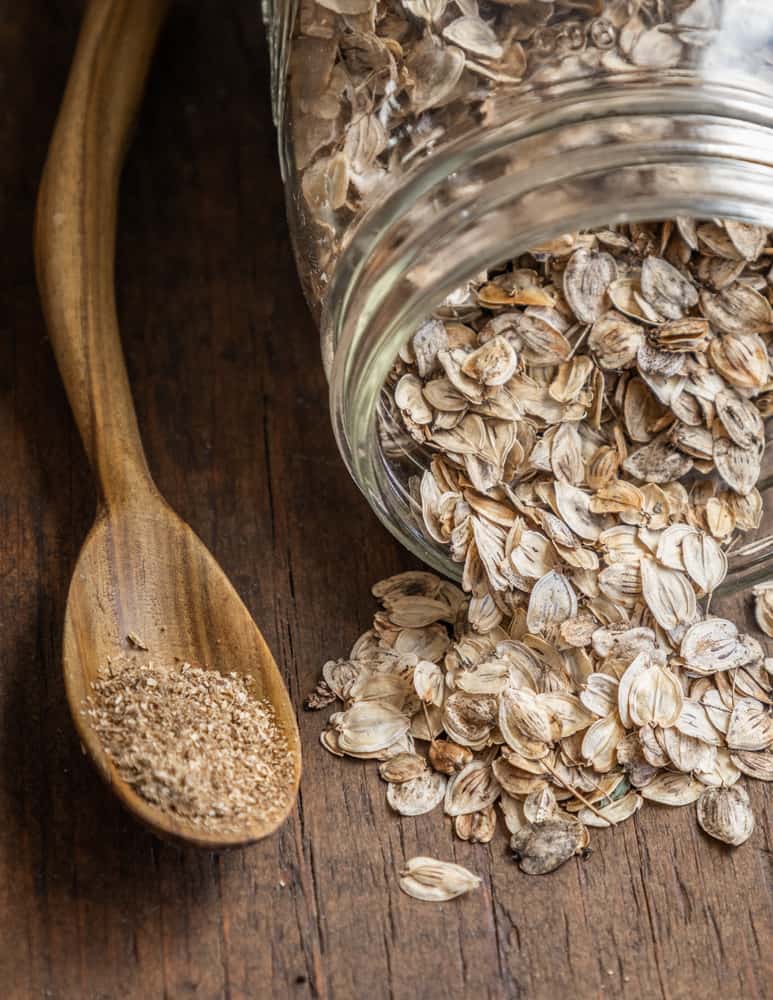
Years ago now I wrote a post on cooking with the seeds, but, as happens, there were a few tricks I didn't know yet that have since helped me to really unlock the best ways to cook with the seeds of the plant, so I'm giving the post a fresh coat of paint to make it more helpful.

Typically, I gather the seeds of Heraculem maximum / common cow parsnip. If you're familiar with the plant and it's seeds, or some of it's cousins that have near identical-tasting seeds, you'll know that it's a strange aroma, something like mixed spices with a touch of black lime, or something like that.
It's a very powerful spice, and at first it was really difficult to work with. Everything I put it in seemed to have a soapy undertone from the strong aroma of the seeds.
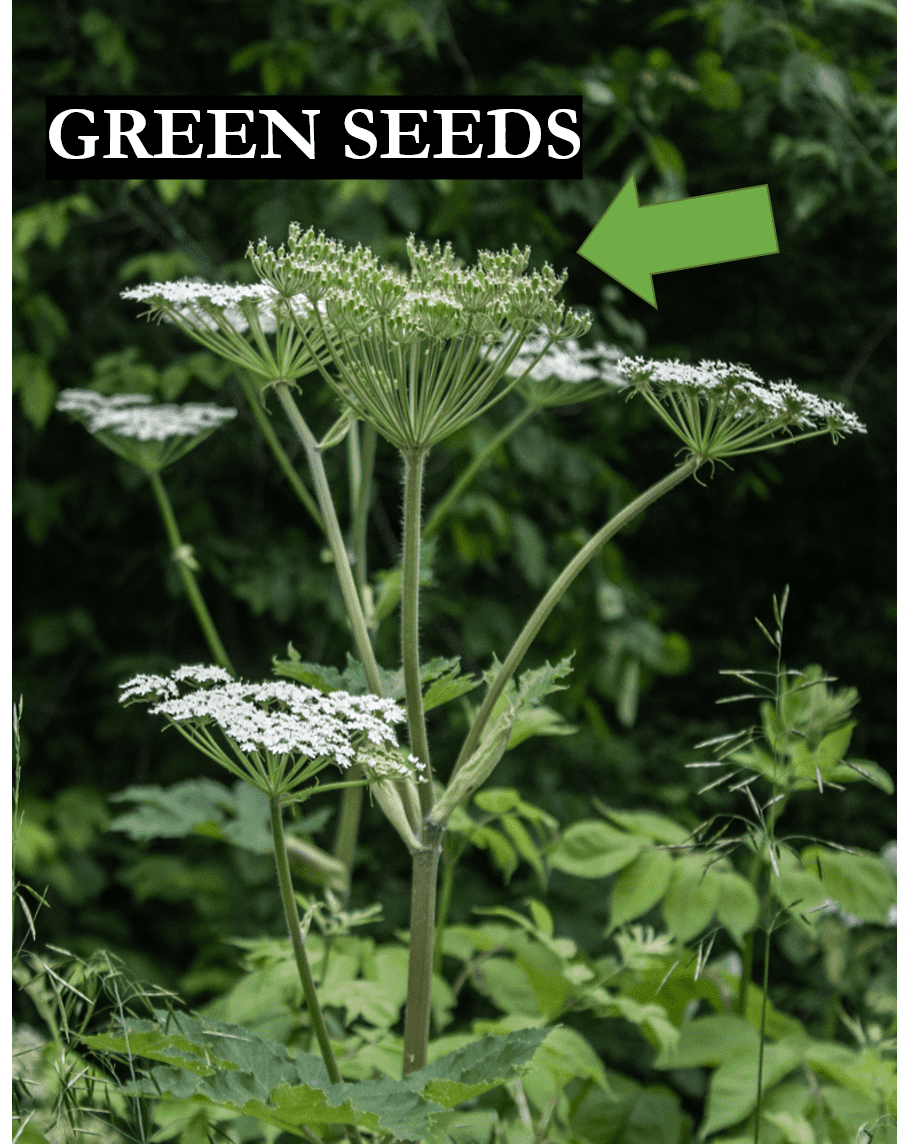
I had some success using the seeds to flavor things that had other potent flavors: blended into harissa paste (arguably my favorite) an aggressive fruit ketchup made from aronia berries and red wine vinegar, as well as sauces made from tomatillos or green tomatoes, and they worked, but I was missing something.
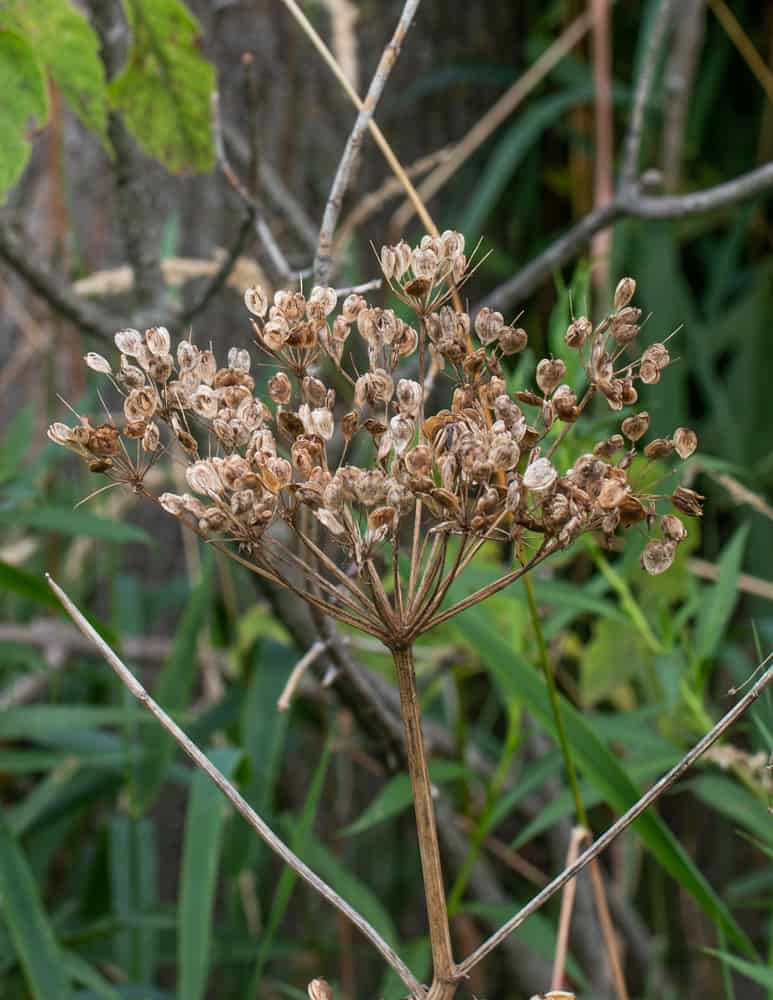
Golpar: an Ancient Persian Spice
As I was writing my book, I did a lot of research into traditional methods of cooking with wild plants around the world and, somewhere, I stumbled across the word golpar while researching traditional uses of angelica.
The spice is a traditional ingredient in Persian/Iranian cooking that you can buy online from all kinds of purveyors, and, as I found out, comes labeled confusingly as angelica, which it isn't, at least not any species of angelica I've eaten.
Excited to work with a variety of angelica seed that might be easier to work with, I bought a jar, and was surprised when I cracked open the lid and immediately knew by the scent that what I got was some species of Heracleum seed-definitely nothing from the genus Angelica, whose seeds are arguably even more difficult to work with than Heracleum.
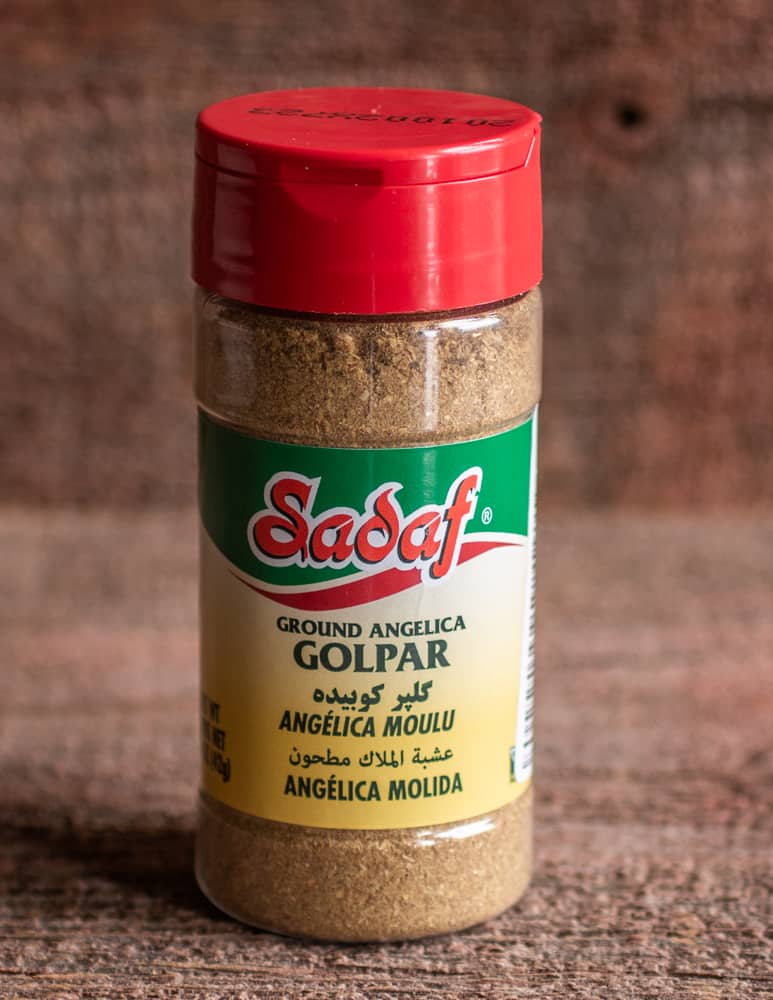
A little confused, but interested, I started following some of the traditional recipes that call for golpar. It should come as no surprise that it worked like a charm. It's a testament to traditional food ways, and a great example of how just knowing the name of a traditional food can be a sort of invocation, a key for opening new doors you didn't know existed.
Typically golpar is used in dishes with legumes, the most famous being freshly cooked fava beans in their pods, but two people with Iranian heritage on Instagram also mentioned they ate it on pomegranites, preferably sour ones.
It's also used in a sort of sweet-sour-pomegranite and olive relish called Zeytoon Parvardeh. Once I tasted legumes seasoned with the golpar, I knew I'd finally tasted what it was supposed to be. There's just something about the complex flavor of the spice that loves legumes-it's magic.
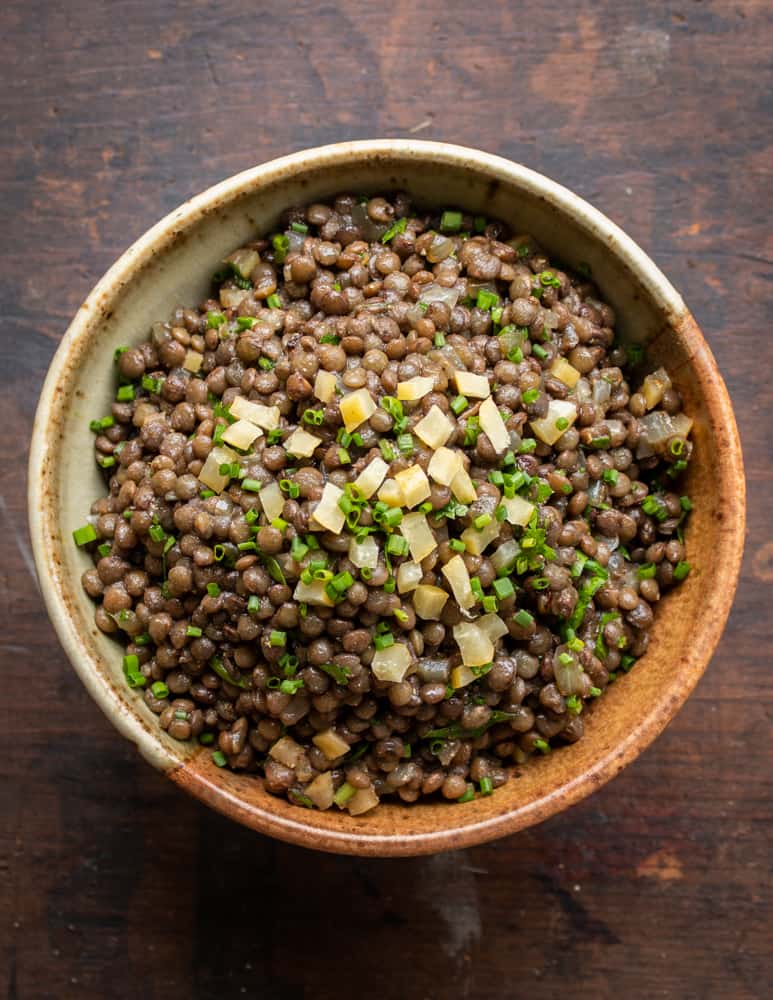
Mixing golpar with cumin
Hands-down, the most useful thing I gleaned from reading traditional recipes is that golpar is often mixed with other spices, typically spices from the Apiaceae/carrot family, specifically cumin. Mixed in equal parts with cumin, the golpar is tamed a bit, making it easier and more palatable for most people.
If you've tried the seeds of the plant before and thought it tasted like soap, try mixing them half and half with cumin-it might change your mind. After I started mixing golpar with other spices, I got the idea to branch out on the theme, and started mixing other spices of related family plants to make blends-a technique I discuss in the essay "The Botany of Spices" in my book.
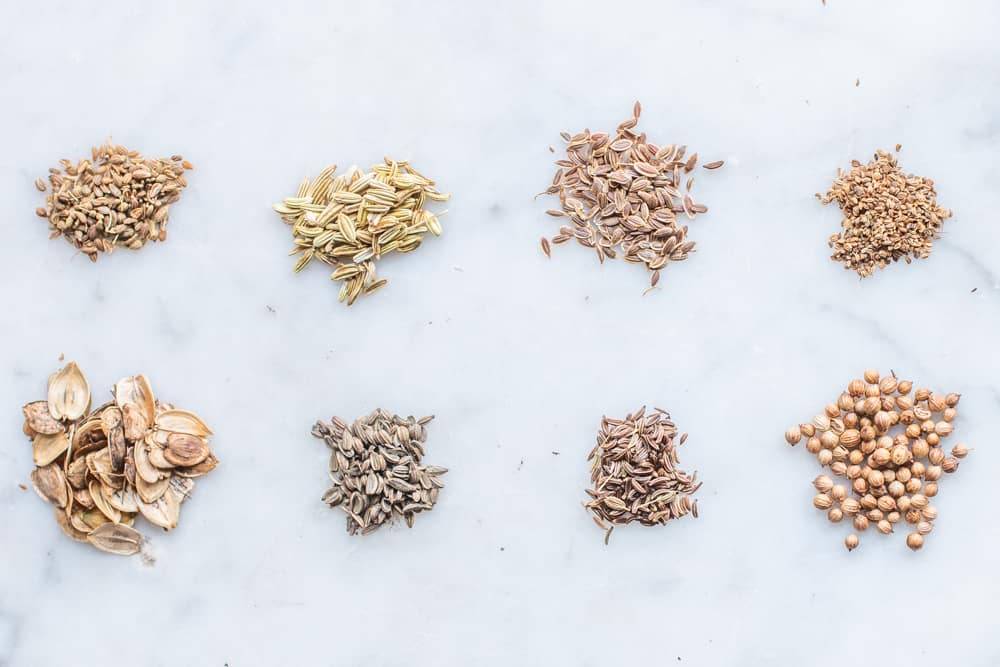
Different species, same flavor
The golpar sold in jars is Heracleum persicum-not the same species of Heracleum as the one I harvest, but the flavor is nearly identical. As some of you will have read in my book, many related plants share similar flavors, and golpar is a perfect example. To date, every species of Heracleum I've eaten has a near identical taste. And there's more.
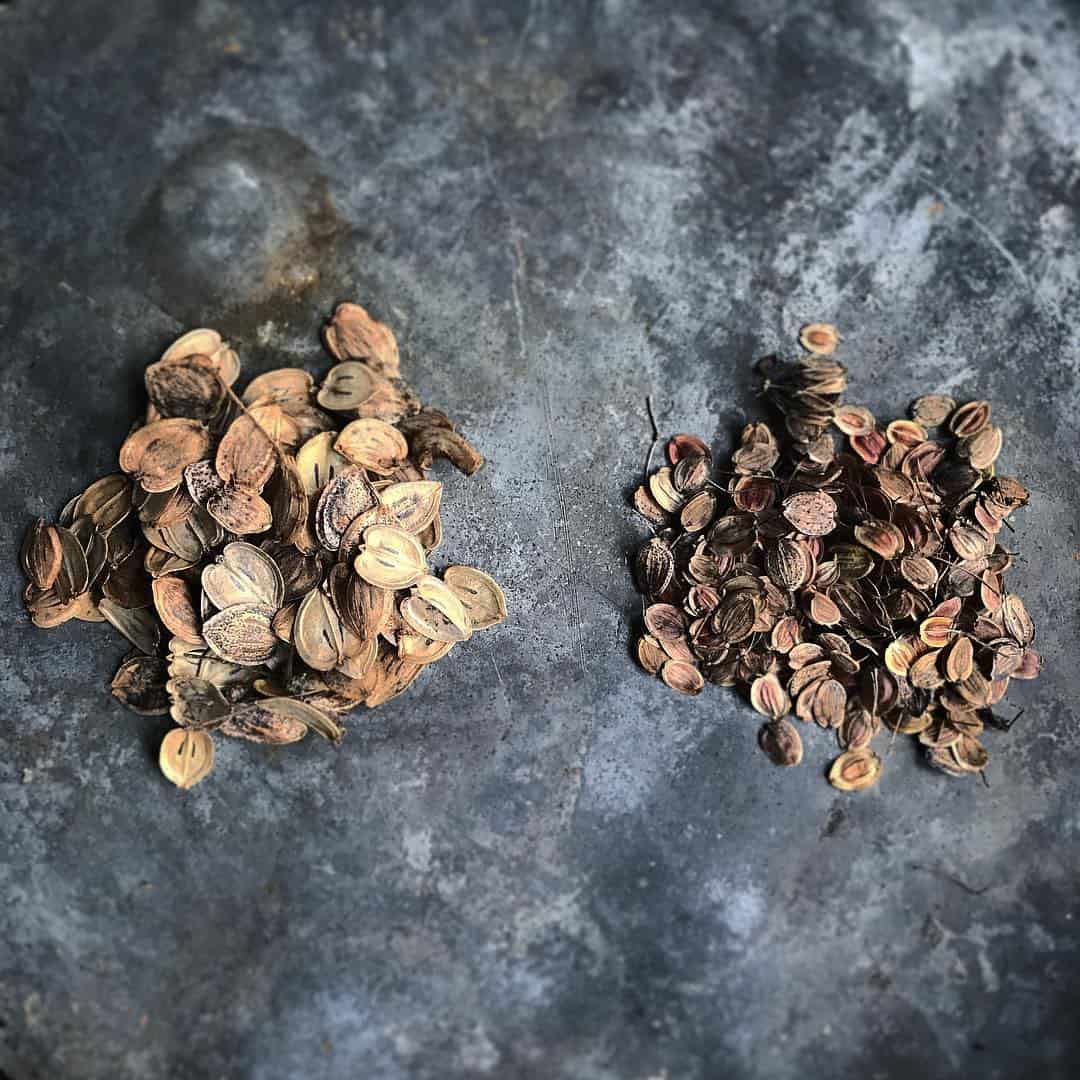
Aside from Heracleum persicum and Heracleum maximum I've already touched on, In Britain, foragers might harvest Heracleum montegazzianum (giant hogweed) most of them simply referring to the spice as hogweed seed.
Interestingly enough, the seeds of wild parsnip, although not in the genus Heracleum, also have seeds interchangeable with Heracleum seeds, although they're a little smaller.
In a keynote speech in 2019, I heard author Stephen Barstow describe the version of golpar he cooks with that comes from Heracleum sphondylium in Norway. So, interestingly, and confusingly, for culinary purposes, you can think of all of the aforementioned plant seeds as golpar.
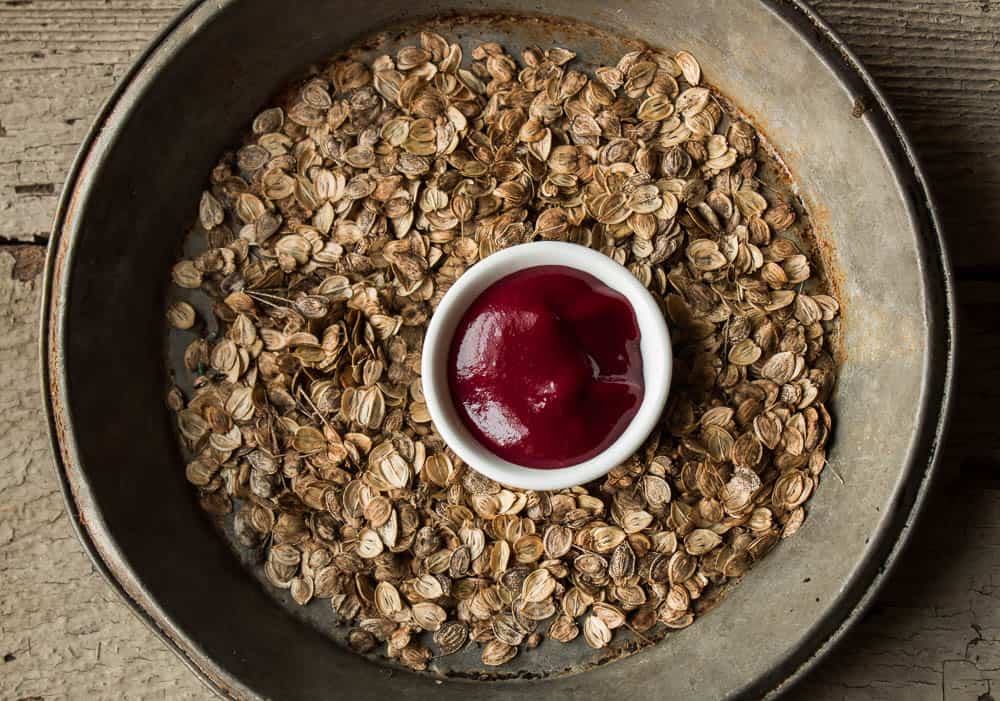
Harvesting
One thing most people know about cow parsnip (angelica and wild parsnip too) is that the sap of the plant is phototoxic and will give you a rash if you get it on your skin in the sunlight. Fortunately, golpar is the dried seeds of the plant harvested at the end of the season (I gather them in August through September).
As the plant is dried out at that point, you can harvest the seeds without gloves, or any worries about getting a rash from touching it as there's no juicy plant sap to worry about when harvesting the seeds.
To harvest the seeds, I take a paper bag, and, holding the umbels with one hand, I gently rub the seeds together with my fingers, making them fall off en-masse. It's an easy harvest, and you can get years worth of the spice in just a few minutes.
Green/Unripe Seeds
I'm pretty sure there's plenty of fun things you can do with the green seeds, which have a great flavor, but I keep forgetting to work with them. They're pretty chewy, but finely chopped I could see them working well in somethings, curry or hot green Zhug, for example. Jacqui, a regular commentor here, sent me a recipe for cordial made from the green seeds that's been on my list to try.
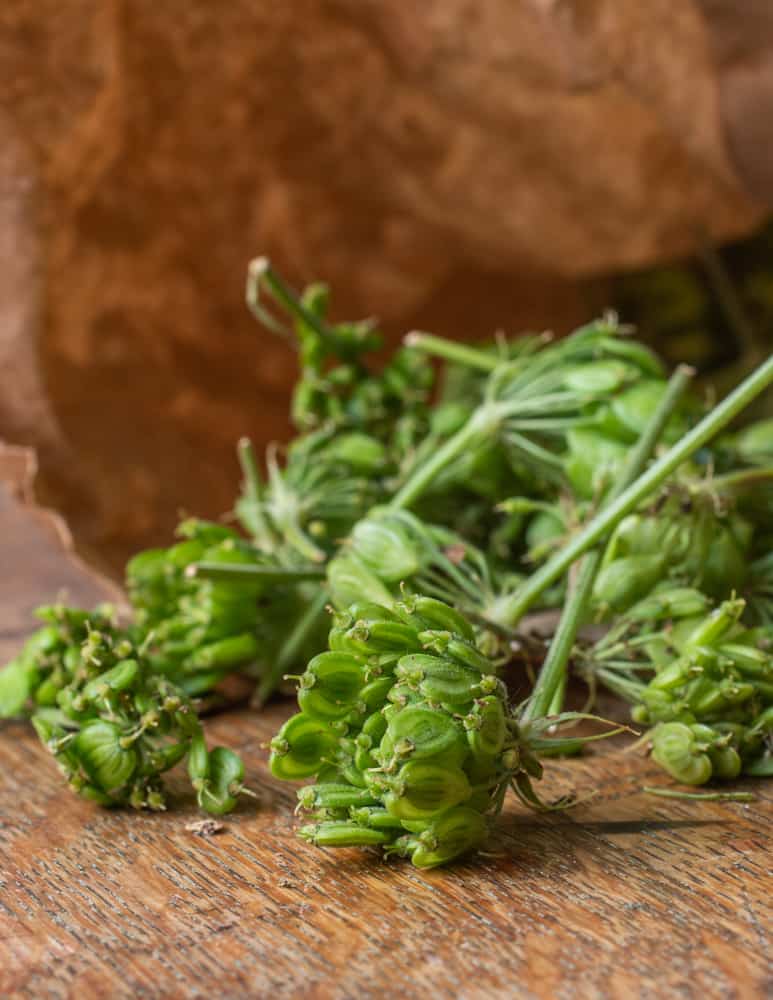
In time I'll probably get some ideas up here on working with green golpar, in the meantime, if you have experience working with the green seeds, leave a comment and I'll update this as time goes on.
As the green seeds are fresh and juicy, remember to wear gloves when harvesting or be mindful of not touching your face, and wash your hands quickly after harvesting them.
Processing
After the seeds are harvested, they're typically pretty dry, but I dehydrate them to ensure they don't mold (100F for 4-5 hours or so in a dehydrator). After drying, the seeds are shelf-stable for years, just like any other dried spice.
Unlike other dried spices though, the outer husk of the seeds is very papery and tough, and, depending on how they were harvested, could also have some tough stems mixed in.
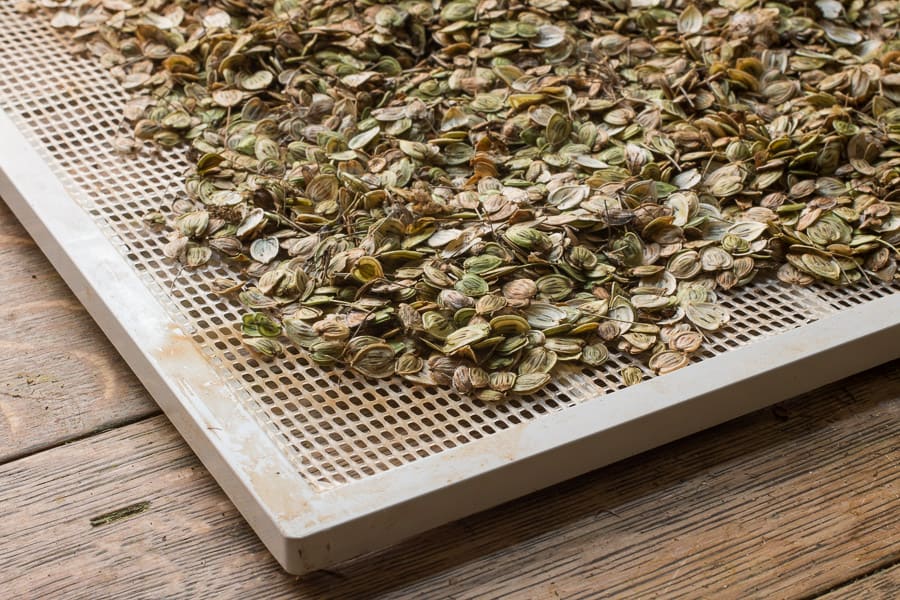
You can add the seeds whole to something that will be blended, pureed and strained to get past the tough texture, but, as long as the seeds are well dried, they can be powdered without too much trouble in a spice grinder before using, and I find that method a lot easier for cooking.
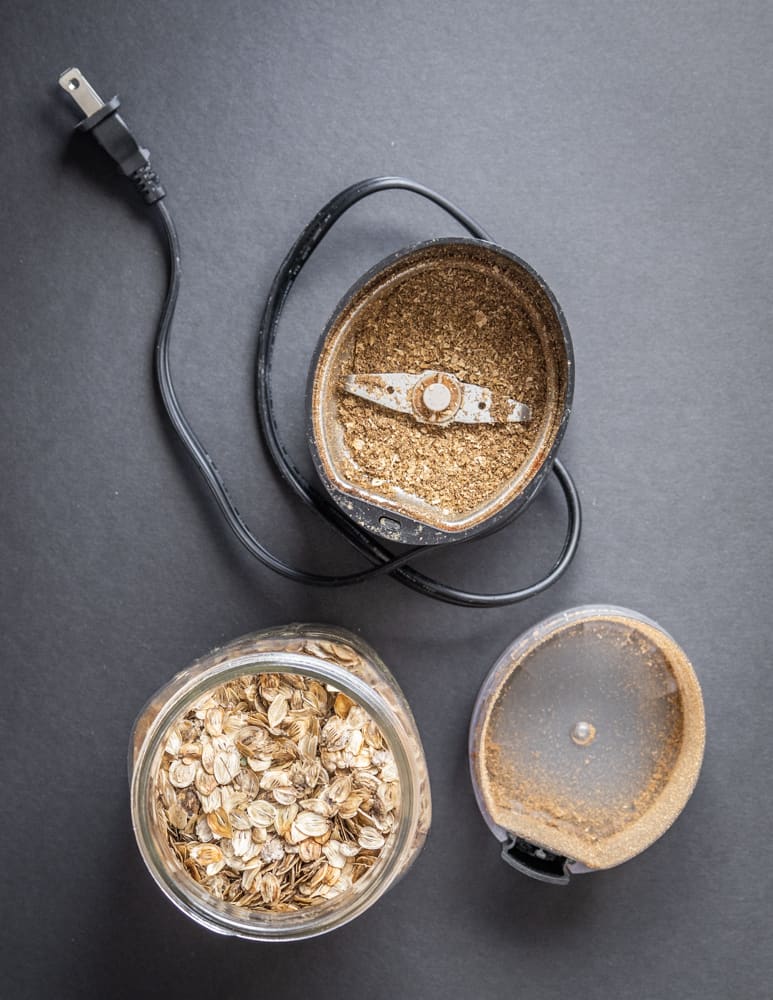
Cooking
As I mentioned, golpar loves legumes, and, similar to ajwain and epazote, I've read claims that using the spice can help make legumes more digestible. Lack of post-dinner music aside, legumes seasoned with golpar mixed with cumin or other spices is just great, and a perfect place to start if you're curious about the plant, or if you've used it before and found it difficult to work with, or unpalatable.


Traditionally, Persian hogweed seeds are used to season broad beans, / fava beans cooked right in their pods, and that's a good, easy recipe to start out with.
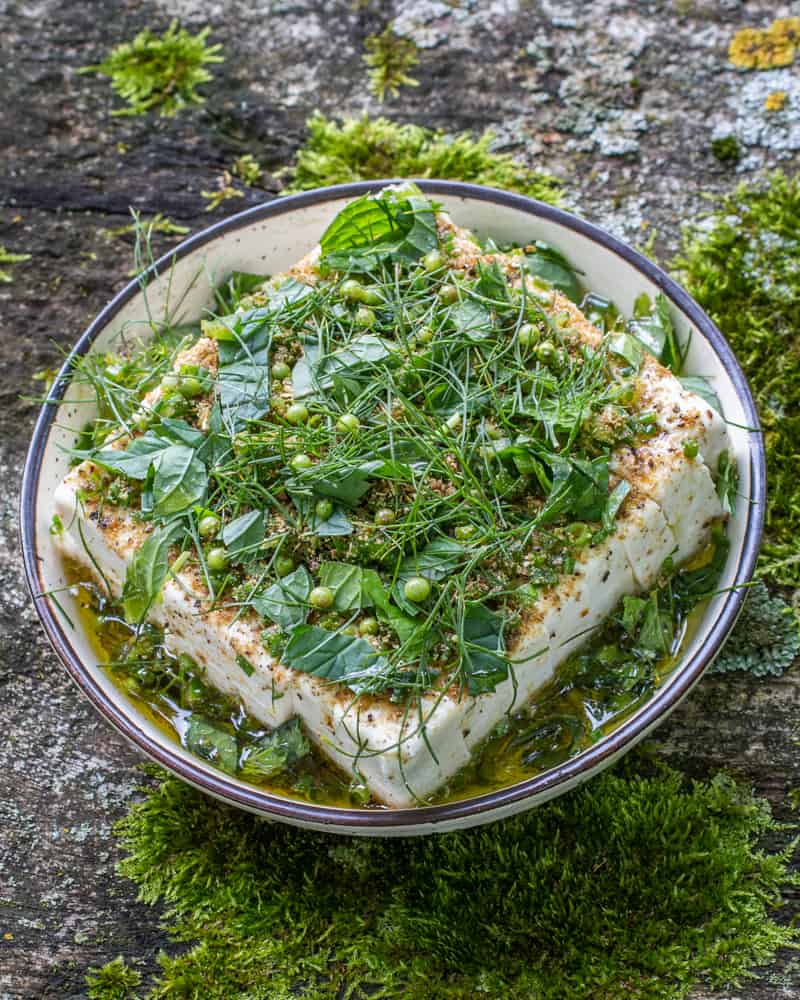
One quick thing to know: unlike most other spices I cook with, golpar doesn't like to be toasted, it's best simply ground and added to things.
The black lentils with golpar I make are probably my favorite way to use the spice to serve to others for the first time, and I was confident enough others would like it to that I served 200 portions of it at the Wild Harvest Festival in 2019. Marinating feta with a mix of golpar, cumin, fresh herbs and lemon (see above) is also crazy good.
If you want more ideas for cooking with the seeds, the golpar tag below will take you to what I have.

Amy
Hi! I've been reading and re-reading your article for a couple of years, and planned on harvesting seeds this year. Here's the problem I run into in our rainy climate--the seeds rot before they ripen on the plant. What do you think about harvesting the green seeds and drying them? Would they still be usable as a spice? Thanks so much!
Alan Bergo
Yes that should work fine.
Sophia
Thanks for this precious information about seed.
Kim Vanderhoek
Love this post thx for the info!
Just came in from foraging a couple cups of seeds and spread them out on a cookie sheet and spiders and tunes beetles are crawling out 🫣 plus I have a lot of the stems ( hair like sticks)
Is there a way to clean the seeds? Or just count on the bugs crawling out? Not too excited about grinding some dried spiders into my spice mix lol
Alan Bergo
Hi Kim. One thing I like to point out is that seeing insects is a good indication that your food hasn't been sprayed with pesticides. Leave the seeds on a tray outside overnight and they should vacate the premises.
Jennifer Hen
Hahaha, I am so glad i found more about the “angelica” seeds I ordered, so i could make the intriguing pound cake recipe you had created for one of your dinners. Imagine my surprise when I popped one of the seeds in my mouth and crunches down! Big eyes, mouth agape, sputtering at the INTENSITY of the cow parsnip seed! How the heck did he make a pound cake dessert out of this, I pondered.
So i let reading and realized you had all the answers already on your fascinating Blog and Facebook page.
Now i will order the correct type of Angelica seed, and make the pound cake, but also try the recipes for the cow parsnip seed.
Living just North of Anchorage Alaska, we have so much cow parsnip to use.
Thank you ,
Alan Bergo
Thanks Jennifer, yeah that's a difficult one to parse if you don't know. Took me years of scratching my head to figure it out.
L. M.
Thank you for your interesting article, but from the photos you posted, the seeds you are talking about are of hogweed, not cow parsley. Hogweed, giant hogweed, cow parsley and wild carrot are all belong to carrot family, but they are not the same thing. Especially, there is a big difference between hogweed and giant hogweed, whilst hogweed is edible (you have showed its green and brown seeds in the photos), the latter is deemed poisonous.
Alan Bergo
All of the plants you've mentioned here are edible. None of them are poisonous. The problem is that they contain furanocoumarins that cause photodermatitis when the sap of the above-ground portion of the plant is on the skin and is exposed to sunlight. Common garden parsnip contains the same compound.
In the article on ancestral borcht I wrote this year, I share images from a book citing documents hundreds of years old that show Heracleum montegazzianum was a traditional food in Poland, and the common name is borcht (an American spelling). Cow parsnip (Heracleum sphondylium in Europe and others around the world) are used similarly.
In my article on Parsnip/Pastinaca sativa, I cite references proving that parsnips in a garden and wild parsnip are botanically identical and the plants will cross-pollinate, besides the books there's additional references to corroborate that at the bottom of the post.
Garden celery and carrots contain the same compounds as these plants and although it doesn't seem to be nearly as strong, some people with individual sensitivities can have a similar effect. Angelica is also related, also gives a rash, and is a popular traditional food sold commercially in Europe to this day.
It's not the plants fault that humans try to remove them in careless ways and get burns in the process. I hope you can find this helpful as it's new information for many people.
justine Janice tompkins
You have such interesting articles. I so enjoy learning about new "stuff" from you. Thank you and keep writing.
Justine
Alan Chomica
Very good article. I wish I could find cow parsnip here on Vancouver Island but have never seen it growing anywhere. I grow Angelica gigas, or Korean Angelica, and have quite a few seeds. Might these also be used to grind into a spice to use like golpar?
I have an interesting Word article on growing Angelica that I can send you via email...
Serena Terra
If it's a type of parsnip are the roots edible?
Do parsnips like we grow in the garden have seeds of this flavor?
Alan Bergo
The roots are stringy, tough, and not worth eating IMO, similar to wild carrot. And yes, garden parsnips are botanically the same plant as wild parsnip, so the seeds can be used interchangeably. Garden parsnip greens will give people a phototoxic rash just like wild parsnip, too.
Gilbert White
Could be good with lovage seed?
Alan Bergo
That could work
Grant
.. 'viola' ... really??
Alan Bergo
Really.
Linda Reinhart
Pushki (cow parsnip) is just turning to seed now here in Alaska. The seeds are soft, round, and green yet. They have an astringent, citrusy flavor - and they taste strongly of (surprise) pushki! Has anyone tried using it at this stage in place of dill in cucumber pickles? I will look tomorrow at our local farmer's market for pickling cucumbers. If I find some I will try it and let you know how it turns out after Thanksgiving - our traditional date for first opening the dill pickles.
David
Just came across this post by chance. I spent a year in Sikkim, India where this, or a very close relative (Heracleum Nepalense) is used very liberally, particularly by Bhutia people in pickles and chutneys. There it's referred to as chimphing. I was looking to replicate this aroma profile back home, and thought it was basically the same as our cow parsnip, so, like you, I decided to take the risk, cautiously, with thoughts of giant hogweed and hemlock in the back of my mind. It turns out it has exactly the same aroma and works really well. I've since found out another variety, which may or may not be the same species, is also used widely in Persian cooking and referred to as golpar.
Alan Bergo
David, yes, you're right, and I agree completely. I was actually speaking with author Stephen Barstow about golpar earlier this year, and I just finished typing up a couple recipes using it for my book. True golpar should be H. persicum, Barstow cooks with H. spondylium (I think) in the Midwest we have H. maximum. Curiously enough, Pastinaca sativa also has the same flavor. It's really fascinating how aromas flow through the genes of plants! Thanks for letting me know about chimphing. It wasn't until I started reading about the different cultures that use the plant that I finally cracked the code on using it, and thoroughly enjoying it. You must try it mixed finely ground, 50/50 with cumin or caraway and used with lentils or beans. --A
David
Thanks for the reply and the suggestions. Yes, I can see how it would go deliciously with pulses.
Jacqui
I have made infused vodka with the unripe (still green) seeds this summer and it has an AMAZING aroma (I haven't tasted it yet, under the perhaps mistaken impression that it will improve on aging... what am I thinking? I'll taste it tomorrow). I used the dried ripe seeds (bruised/ground with my basalt pestle and mortar) in a winter squash soup. It was really fabulous.
I plan to use them in carrot cake and carrot soup in a nearish future as well as in many a curry...
Melissa Hoffman
I so appreciate your detailed posts. As I gather these seeds myself, I have found the aroma captivating. I have some infusing in vodka, to then mix into a wild noccino (instead of orange peel). It's always refreshing to learn of your experimentation with so many similar plants as we have on our farm. Thank you again for your generosity.
Alan Bergo
Thanks Melissa. Yeah I've been so in love with these seeds.
patrick
where can I buy two pounds of cow parsnip seeds
Alan Bergo
What would you need two lbs of seeds for? That is a lot of seeds. I don't know where you could buy them. Much easier and cheaper to pick yourself. Maybe look into some of the forums on Facebook and ask around.